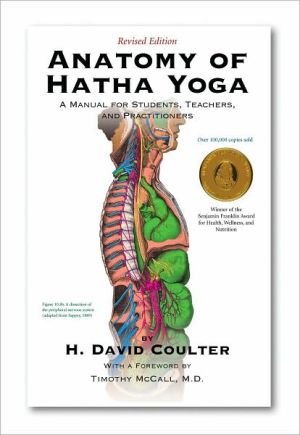Anatomy of Hatha Yoga: A Manual for Students, Teachers and Practitioners
Anatomy of Hatha Yoga—revised and updated with full color illustrations and photos—is the most comprehensive and authoritative work available correlating the study of hatha yoga with anatomy and physiology. It is a must-have for anyone who is serious about studying or teaching yoga, and an invaluable resource for anyone in a field relating to physical conditioning. The author holds a PhD in Anatomy and was a sought-after professor, teacher and yoga practitioner for over thirty years. He lived...
Search in google:
Foreword11Preface13Introduction15Basic Premises17Chapter 1Movement and Posture21The Neuro-musculoskeletal System22The Nervous System29Reflexes36The Vestibular System, Sight, and Touch47Connective Tissue Restraints51Stretching60Three Postures62Putting It All Together66Chapter 2Breathing67The Design of the Respiratory System68The Muscles of Respiration74How Breathing Affects Posture82The Somatic and Autonomic Systems85The Physiology of Respiration91Thoracic Breathing102Paradoxical Breathing107Supine Abdominal Breathing108Abdominal Breathing in Sitting Postures111Diaphragmatic Breathing120A Traditional Warning131Chapter 3Abdominopelvic Exercises139Crunches and Sit-ups140The Foundation of the Body141Supine Leg Lifts160Yoga Sit-ups169The Sitting Boat Postures171The Peacock173The Pelvis and The Anatomical Perineum177Ashwini Mudra182Mula Bandha183Agni Sara188Uddiyana Bandha, The Abdominal Lift195Nauli201Contraindications204Benefits205Chapter 4Standing Postures207The Skeletal System and Movement210Anatomy of the Spine215Symmetry and Asymmetry227Standing Postures228Four Simple Stretches230Backward Bending236Forward Bending240Side Bending249What Makes Postures Difficult?254The Triangle Postures255Two Balancing Postures267Benefits271Chapter 5Backbending Postures273The Anatomy of Flexion and Extension274Breathing and Backbending280The Cobra Postures284The Locust Postures296The Prone Boat Postures303The Bow Postures305The Knee Joint307Supine Backbending Postures312A Kneeling Backbend--The Camel320Contraindications323Benefits324Chapter 6Forward Bending Postures325Forward Bending: Head, Neck, and Chest326Lumbar and Lumbosacral Forward Bending327Sacroiliac Nutation and Counternutation328Forward Bending at the Hip Joints332Forward Bending at the Ankles and in the Feet334Clinical Matters and Cautions337The Posterior Stretch340The Down-Facing Dog349The Child's Pose352Breathing and Forward Bending353Sacroiliac Flexibility355Hip Flexibility361Benefits381Chapter 7Twisting Postures383The Fundamentals of Twisting384The Skull, the Atlas, and the Axis388Movements of the Head and Neck392Thoracic Twisting395Lumbar Twisting396The Lower Extremities398Supine Twists403Standing Twists410Inverted Twists424Sitting Spinal Twists425Benefits435Chapter 8The Headstand437The Cardiovascular System437The Two Headstands446The Upper Extremities455Structural Imbalances471Breathing Issues474Developing Strength and Flexibility477Bending and Twisting in the Headstand488Extending Your Time493Benefits497Chapter 9The Shoulderstand499Anatomy of The Shoulderstand500Inverted Action Postures503The Shoulderstand507The Plow516The Lifted Shoulderstand and Plow522Circulation524Respiration526Sequelae528Benefits539Chapter 10Relaxation and Meditation541Muscular Relaxation543Two Relaxation Postures547Breathing and Relaxation552The Autonomic Nervous System554Deepening Relaxation562Meditation Postures565Maintaining the Geometry566Props572The Six Postures575Mula Bandha588Mastering the Situation589Knower of the Veil593Glossary595Additional Sources607Acknowledgments609Index of Anatomical Terms611Index of Practices619Biographical Sketch623
\ BooknewsCoulter, who received a PhD in anatomy in 1968, and has taught in numerous contexts since then, has also been a student of yoga since the 1970s. Here he conjoins his two areas of expertise. After discussion of basic premises regarding yoga practice<-->focusing attention, becoming aware of breath, moving into and out of postures, responding to pain<-->he discusses movement and posture, breathing, and abdominopelvic exercises, and then explores in detail the various standing, backbending, forward bending, twisting, and inverted postures, as well as relaxation and meditation. In his densely packed explications and descriptions, he variously addresses yoga teachers, yoga students, and medical practitioners; and this leaping about from audience to audience lends a clutter to the presentation. Still, there's valuable information here for readers in all three groups. Annotation c. Book News, Inc., Portland, OR (booknews.com)\ \ \ \ \ From The CriticsReviewer: Martha J. Greenberg, PhD, RN(Pace University)\ Description: This book describes the philosophy and postures of hatha yoga with an objective analysis correlating these postures with biomedicine. Using anatomically precise terminology, the book discusses the effects of hatha yoga on major body systems. \ Purpose: The book provides a comprehensive overview of anatomy and physiology of hatha yoga with special emphasis on the musculoskeletal, nervous, and cadiovascular systems. The book exceeds the author's objectives and fills a void in the literature, bridging biomedicine and complementary medicine. \ Audience: Every yoga teacher as well as any health professional or layperson interested in exploring the anatomical and physiologic aspects of hatha yoga should own this unique publication. Dr. Coulter brings over 25 years' teaching experience in science and hatha yoga to this book. His writing style should satisfy and appeal to a range of disciplines and individuals at varying educational and professional levels. \ Features: The author discusses the basic premises of hatha yoga with foundational material accepted in biomedical sciences, expressly avoiding comment on non-physical concepts such as prana and the chakras. All postures are discussed in detail and depicted in excellent quality black-and-white photographs. Steps in the postures are illustrated as well as terminal points of the positions.\ Assessment: The book presents hatha yoga in scientific terms while at the same time respecting its principles. Marrying academic discourse with detailed and pictorial representations of postures, it is a premier book in the field.\ \ \ 4 Stars! from Doody\ \








